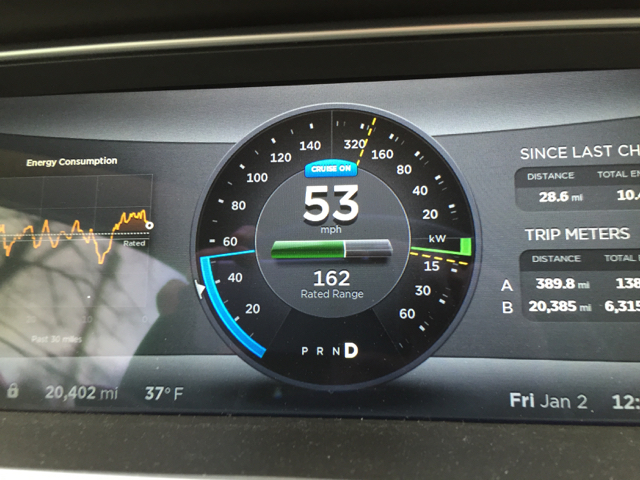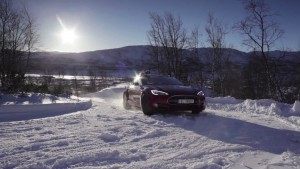News
Winter Quirks with Tesla’s Cruise Control System

I use cruise control a lot when driving. Highways, back roads, you name it. My main motive for using cruise control as much as I do is to avoid the urge to speed. After all, it’s far too easy to speed in the Model S with its smooth instant acceleration and lack of engine noise.
I did a fairly detailed review of the Model cruise control system back in the spring of 2014 but it turns out there’s more to the story than I originally thought. The frigid New England temperatures have affected battery range and the ability to use regenerative braking but little did I know that it would also affect the cruise control system.
Model S Cruise Control and Cold Weather
Cruise control is designed to maintain a constant speed without having to use the accelerator pedal. On level terrain it’s pretty reliable in terms of keeping a constant speed, but results begin to vary when going downhill with cruise control on.
In most ICE cars, cruise control will not apply the brakes but will leave the car in gear allowing the vacuum of the engine and engine braking to slow the car down. Some cars will also downshift to further increase engine braking as a means of slowing the vehicle.
The Model S on the other hand has no engine or transmission that can be used for engine braking. Because of this the Model S cruise control system relies strictly on the effects of regenerative braking to slow the car down. When regenerative braking is limited, the rate in which the vehicle decelerates is also limited which in turn limits the ability for the vehicle to automatically slow down.

Tesla Model S cruise control ineffective when regenerative braking is limited due to cold weather conditions.
In the image above, I had cruise control set at 40MPH but because of the limited regenerative braking due to cold weather combined with a down hill decent, the Model S ended up plowing right past the 40 MPH mark as gravity took hold of the car. I ended up speeding 13 MPH over the cruise control speed.
Model S owners get to choose between standard and low regenerative braking but it doesn’t make that much of a difference during cold weather conditions since regen as a whole will be limited.
There is Tesla Life Outside of California
Some California Tesla friends were surprised that I was concerned about this winter quirk. Their thought was that the Model S would operate normally after a short warm up period and this issue shouldn’t be considered a big deal. They suggested I accelerate hard a few times to get the vehicle back to “normal” temperatures but that’s easier said than done when you’re dealing with winter road conditions.

Warming 7,000 battery cells up to optimal operating temperatures takes time. Here in New England with temperatures well below the 40’s, it often takes 45 minutes of highway driving before regen kicks back in and can accept over 30kW. But more often than not I’m driving without regenerative braking because of the cold weather.
30kW of regenerative braking is needed for slowing the car down. Anything less and the car begins to gain speed as it begins to roll downhill. How fast it gains speed really depends on how limited the regen is.
If you live in colder climates and use cruise control on your Model S, beware of this winter quirk or run the risk of picking up a hefty speeding ticket.

News
Tesla FSD fleet is nearing 7 billion total miles, including 2.5 billion city miles
As can be seen on Tesla’s official FSD webpage, vehicles equipped with the system have now navigated over 6.99 billion miles.

Tesla’s Full Self-Driving (Supervised) fleet is closing in on almost 7 billion total miles driven, as per data posted by the company on its official FSD webpage.
These figures hint at the massive scale of data fueling Tesla’s rapid FSD improvements, which have been quite notable as of late.
FSD mileage milestones
As can be seen on Tesla’s official FSD webpage, vehicles equipped with the system have now navigated over 6.99 billion miles. Tesla owner and avid FSD tester Whole Mars Catalog also shared a screenshot indicating that from the nearly 7 billion miles traveled by the FSD fleet, more than 2.5 billion miles were driven inside cities.
City miles are particularly valuable for complex urban scenarios like unprotected turns, pedestrian interactions, and traffic lights. This is also the difference-maker for FSD, as only complex solutions, such as Waymo’s self-driving taxis, operate similarly on inner-city streets. And even then, incidents such as the San Francisco blackouts have proven challenging for sensor-rich vehicles like Waymos.
Tesla’s data edge
Tesla has a number of advantages in the autonomous vehicle sector, one of which is the size of its fleet and the number of vehicles training FSD on real-world roads. Tesla’s nearly 7 billion FSD miles then allow the company to roll out updates that make its vehicles behave like they are being driven by experienced drivers, even if they are operating on their own.
So notable are Tesla’s improvements to FSD that NVIDIA Director of Robotics Jim Fan, after experiencing FSD v14, noted that the system is the first AI that passes what he described as a “Physical Turing Test.”
“Despite knowing exactly how robot learning works, I still find it magical watching the steering wheel turn by itself. First it feels surreal, next it becomes routine. Then, like the smartphone, taking it away actively hurts. This is how humanity gets rewired and glued to god-like technologies,” Fan wrote in a post on X.
News
Tesla starts showing how FSD will change lives in Europe
Local officials tested the system on narrow country roads and were impressed by FSD’s smooth, human-like driving, with some calling the service a game-changer for everyday life in areas that are far from urban centers.

Tesla has launched Europe’s first public shuttle service using Full Self-Driving (Supervised) in the rural Eifelkreis Bitburg-Prüm region of Germany, demonstrating how the technology can restore independence and mobility for people who struggle with limited transport options.
Local officials tested the system on narrow country roads and were impressed by FSD’s smooth, human-like driving, with some calling the service a game-changer for everyday life in areas that are far from urban centers.
Officials see real impact on rural residents
Arzfeld Mayor Johannes Kuhl and District Administrator Andreas Kruppert personally tested the Tesla shuttle service. This allowed them to see just how well FSD navigated winding lanes and rural roads confidently. Kruppert said, “Autonomous driving sounds like science fiction to many, but we simply see here that it works totally well in rural regions too.” Kuhl, for his part, also noted that FSD “feels like a very experienced driver.”
The pilot complements the area’s “Citizen Bus” program, which provides on-demand rides for elderly residents who can no longer drive themselves. Tesla Europe shared a video of a demonstration of the service, highlighting how FSD gives people their freedom back, even in places where public transport is not as prevalent.
What the Ministry for Economic Affairs and Transport says
Rhineland-Palatinate’s Minister Daniela Schmitt supported the project, praising the collaboration that made this “first of its kind in Europe” possible. As per the ministry, the rural rollout for the service shows FSD’s potential beyond major cities, and it delivers tangible benefits like grocery runs, doctor visits, and social connections for isolated residents.
“Reliable and flexible mobility is especially vital in rural areas. With the launch of a shuttle service using self-driving vehicles (FSD supervised) by Tesla in the Eifelkreis Bitburg-Prüm, an innovative pilot project is now getting underway that complements local community bus services. It is the first project of its kind in Europe.
“The result is a real gain for rural mobility: greater accessibility, more flexibility and tangible benefits for everyday life. A strong signal for innovation, cooperation and future-oriented mobility beyond urban centers,” the ministry wrote in a LinkedIn post.
News
Tesla China quietly posts Robotaxi-related job listing
Tesla China is currently seeking a Low Voltage Electrical Engineer to work on circuit board design for the company’s autonomous vehicles.

Tesla has posted a new job listing in Shanghai explicitly tied to its Robotaxi program, fueling speculation that the company is preparing to launch its dedicated autonomous ride-hailing service in China.
As noted in the listing, Tesla China is currently seeking a Low Voltage Electrical Engineer to work on circuit board design for the company’s autonomous vehicles.
Robotaxi-specific role
The listing, which was shared on social media platform X by industry watcher @tslaming, suggested that Tesla China is looking to fill the role urgently. The job listing itself specifically mentions that the person hired for the role will be working on the Low Voltage Hardware team, which would design the circuit boards that would serve as the nervous system of the Robotaxi.
Key tasks for the role, as indicated in the job listing, include collaboration with PCB layout, firmware, mechanical, program management, and validation teams, among other responsibilities. The role is based in Shanghai.
China Robotaxi launch
China represents a massive potential market for robotaxis, with its dense urban centers and supportive policies in select cities. Tesla has limited permission to roll out FSD in the country, though despite this, its vehicles have been hailed as among the best in the market when it comes to autonomous features. So far, at least, it appears that China supports Tesla’s FSD and Robotaxi rollout.
This was hinted at in November, when Tesla brought the Cybercab to the 8th China International Import Expo (CIIE) in Shanghai, marking the first time that the autonomous two-seater was brought to the Asia-Pacific region. The vehicle, despite not having a release date in China, received a significant amount of interest among the event’s attendees.








